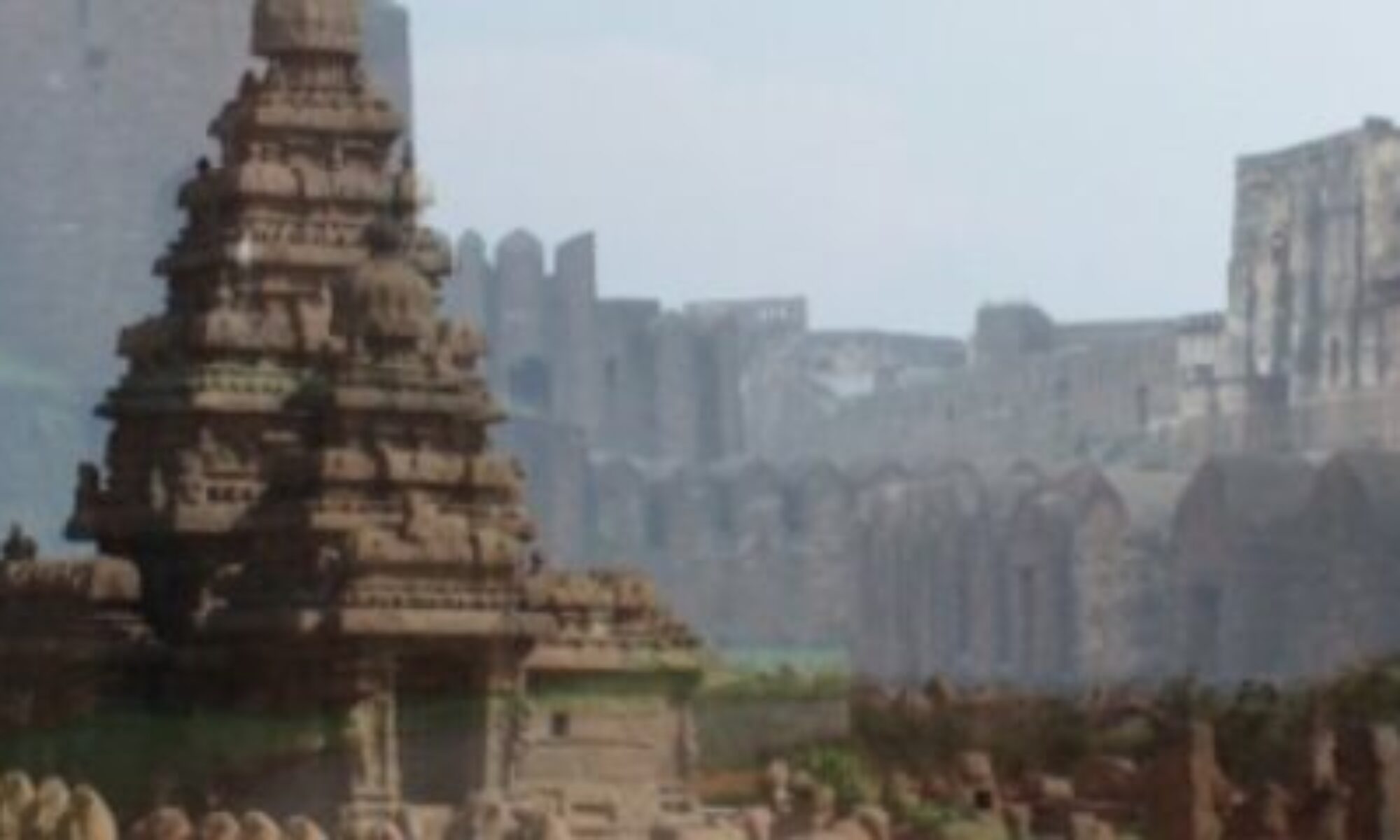Cave 3: Among the caves of the first group, this is the most prominent and largest one. This is a huge 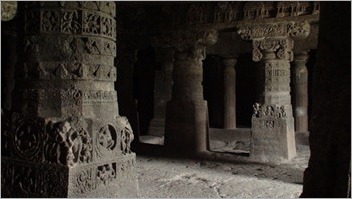 monastery, the plan resembles with tho
monastery, the plan resembles with tho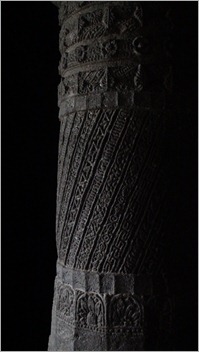 se of Ajanta. It consists of a pillared verandah with cells on either side, a square pillared hall with two sides on the sides, a pillared porch, and a shrine. The pillars of the square hall are arranged in a square and are richly caved with floral and geometrical designs. Carvings are also noticed in the lintel above the pillars which tell the Jataka stories. From the outside, this chaitya seems like a very simple one for the completely plain and raw architecture. However, once you step inside, you will see the marvel as depicted in these pictures. It must have taken months together to get this shrine in place. Right from the bottom of the pillars to the lintel, are carved with various figures. In the middle, is the sanctum which houses the Buddha in preaching attire. The enclosures on the sides are empty.
se of Ajanta. It consists of a pillared verandah with cells on either side, a square pillared hall with two sides on the sides, a pillared porch, and a shrine. The pillars of the square hall are arranged in a square and are richly caved with floral and geometrical designs. Carvings are also noticed in the lintel above the pillars which tell the Jataka stories. From the outside, this chaitya seems like a very simple one for the completely plain and raw architecture. However, once you step inside, you will see the marvel as depicted in these pictures. It must have taken months together to get this shrine in place. Right from the bottom of the pillars to the lintel, are carved with various figures. In the middle, is the sanctum which houses the Buddha in preaching attire. The enclosures on the sides are empty.
Cave 4: This is a typical Chaityagriha of the Hinayana period. It has a stupa with the typical 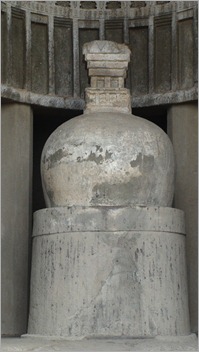 square at its
square at its 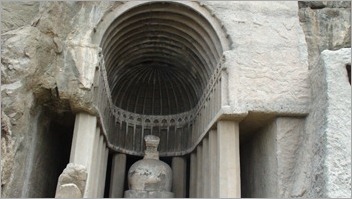 top. This could have been constructed centuries earlier than the other caves of this location. In earlier times, there would have been a wooden ceiling, however today we see that it has been poorly replicated with cement. Even the pillars have vanished and are repl
top. This could have been constructed centuries earlier than the other caves of this location. In earlier times, there would have been a wooden ceiling, however today we see that it has been poorly replicated with cement. Even the pillars have vanished and are repl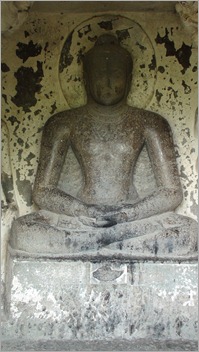 aced by the modern cement ones. The only thing intact is the stupa in the middle. Interestingly, this chaitya has not faced the modification according to Mahayana rites. Normally as seen in other places like Ajanta, there would be a Buddha statue placed in front of the stupa but here it retains the original structure. Other than this, there i
aced by the modern cement ones. The only thing intact is the stupa in the middle. Interestingly, this chaitya has not faced the modification according to Mahayana rites. Normally as seen in other places like Ajanta, there would be a Buddha statue placed in front of the stupa but here it retains the original structure. Other than this, there i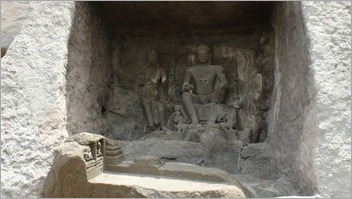 s nothing in this cave that is worth noteworthy.
s nothing in this cave that is worth noteworthy.
Cave 5: Cave 5 is a very small cave where you find Buddha in a dhyanamudra in the padmansana. The idol is worn out but still intact, probably that it was made in a hard stone. There is another small enclosure below this cave where there is a Buddha in preaching attire with Padmapani and Vajrapani on each side. One of the consorts has completely vanished and the other not recognizable. 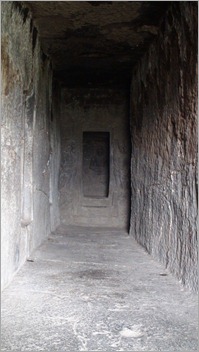
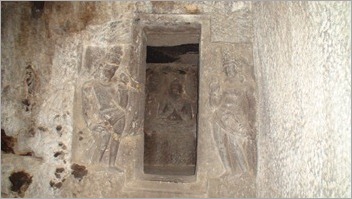 Cave 6: The first in this second series of caves, combines the features of a Chaitya Hall and a Vihara. It has an ante-chamber and a shrine as also cells on three sides. The shrine contains a huge Buddh
Cave 6: The first in this second series of caves, combines the features of a Chaitya Hall and a Vihara. It has an ante-chamber and a shrine as also cells on three sides. The shrine contains a huge Buddh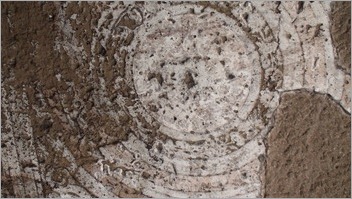 a with attendants. One of the cells has a stone bed. The other two have Buddha image in them. The roof of the verandah shows some fragments of paintings. These paintings have been dated to around 4th century A.D. which clearly places them in line with the time the caves have been excavated. Most of the parts of the paintings have worn out and even today little pieces fall down from the ceiling. It is only matter
a with attendants. One of the cells has a stone bed. The other two have Buddha image in them. The roof of the verandah shows some fragments of paintings. These paintings have been dated to around 4th century A.D. which clearly places them in line with the time the caves have been excavated. Most of the parts of the paintings have worn out and even today little pieces fall down from the ceiling. It is only matter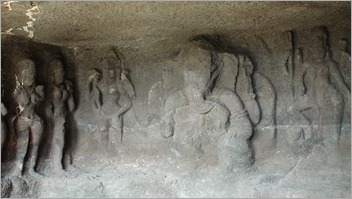 of some years before this entire ceiling will look plain.
of some years before this entire ceiling will look plain.
There is one cave which does not fall in line with the others in this area. Interestingly, this is dedicated to Hindu iconography. I am sure that this is of a later period, however it does not seem to be too later. The idols are completely disfigured. One thing we know is that the cave is dedicated to Ganesha. The idol is attended by lady consorts on either side and are images of women worshippers are carved on the walls at either side.
Cave 7: This is the most important and complete caves in this whole stretch. This is a chaityagriha, with a 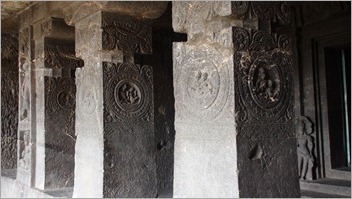 circumambulation and with an outer corridor around this hall separated from the hall by a row of pillars. It has a large inner cell with an image chamber. The two chapels at the end of the verandah and the cells at the back of the cave are filled with exquisitely carved figures. There are six cells which served
circumambulation and with an outer corridor around this hall separated from the hall by a row of pillars. It has a large inner cell with an image chamber. The two chapels at the end of the verandah and the cells at the back of the cave are filled with exquisitely carved figures. There are six cells which served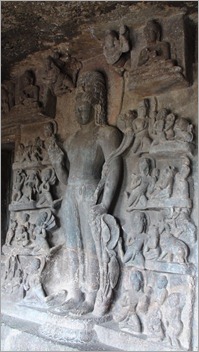 as living quarters for monks. The sculptures are characteristic of Mahayana mythology and are marked with a creative vigor which attained its epitome in the Brahmanical sculptures of Ellora.
as living quarters for monks. The sculptures are characteristic of Mahayana mythology and are marked with a creative vigor which attained its epitome in the Brahmanical sculptures of Ellora.
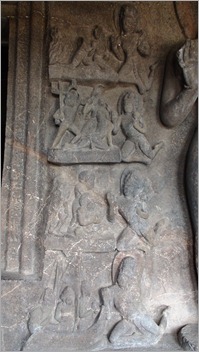 On the verandah’s back wall, to the left of the door, is a colossal figure of Bodhisattva Padmapani. As we know, he is often seen with the Buddha in similar caves. For, among the life forms, both human and animal, through which the great teacher passed before he assumed the form in which he attained Enlightenment, Bodhisattva Padmapani was closest to him in the process of evolution.
On the verandah’s back wall, to the left of the door, is a colossal figure of Bodhisattva Padmapani. As we know, he is often seen with the Buddha in similar caves. For, among the life forms, both human and animal, through which the great teacher passed before he assumed the form in which he attained Enlightenment, Bodhisattva Padmapani was closest to him in the process of evolution.
In this stone composition, there are eight scenes of Buddhist prayers which invokes the near-Buddha thus: Fi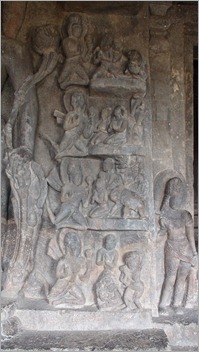 re, sword of enemy, fetters of slavery, drowning in water, lion, elephant and reptile. These eight fears are dramatized in four sculptures on either side of Padmapani. In each, two figures are praying to the Lord. The top sculpture on one side depicts fire as danger, enemy’s sword, chains, shipwreck, attack by lion, snake and maddened
re, sword of enemy, fetters of slavery, drowning in water, lion, elephant and reptile. These eight fears are dramatized in four sculptures on either side of Padmapani. In each, two figures are praying to the Lord. The top sculpture on one side depicts fire as danger, enemy’s sword, chains, shipwreck, attack by lion, snake and maddened 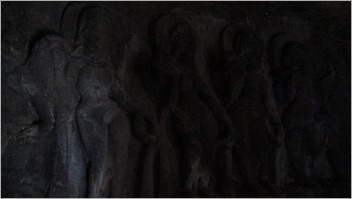 elephant. Death is symbolized by a demon about to snatch from its mother’s lap. This scene recurs in another medium, painting at Ajanta. On the right side of the door is another huge Bodhisattva, Vajrapani. The female on his right is Saraswathi, the goddess of learning. Overhear, there are gandharvas, celestial beings etc. The prof
elephant. Death is symbolized by a demon about to snatch from its mother’s lap. This scene recurs in another medium, painting at Ajanta. On the right side of the door is another huge Bodhisattva, Vajrapani. The female on his right is Saraswathi, the goddess of learning. Overhear, there are gandharvas, celestial beings etc. The prof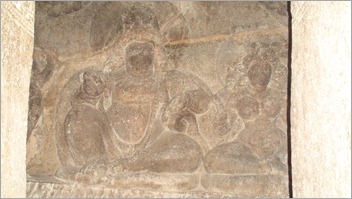 usion of goddess is an indication that Buddhism was now shorn of its original austerity and reconciled to the older Brahmanic ritual. Sentiment had overlapped the stern, puritanical faith and filled the plastic art it inspired with an exuberance of spirit, the source of a new–worn richness. Brahmanical mythology had its influence both in Buddhist and Jain religion. Some of the Gods of Jain are typical Hindu characters like Indra. There is one last cave in this series which is notable. Cave 8 is an
usion of goddess is an indication that Buddhism was now shorn of its original austerity and reconciled to the older Brahmanic ritual. Sentiment had overlapped the stern, puritanical faith and filled the plastic art it inspired with an exuberance of spirit, the source of a new–worn richness. Brahmanical mythology had its influence both in Buddhist and Jain religion. Some of the Gods of Jain are typical Hindu characters like Indra. There is one last cave in this series which is notable. Cave 8 is an 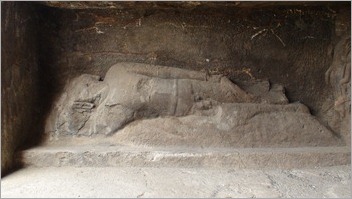 half excavated one with no importance.
half excavated one with no importance.
Cave 9:This is a group of three shrine complexes approached from a long oblong verandah. The important panel here is the Buddha in the Mahaparinirvana, which is located in the left wall of the verandah. There are three other caves, one in this part and two about 500 meters from the second series. All of them are incomplete and there is nothing to visit.
These caves are only part of the multi-cultured atmosphere that Aurangabad offers. We will talk more about the city and visit some important destinations inside the city in the following post.
